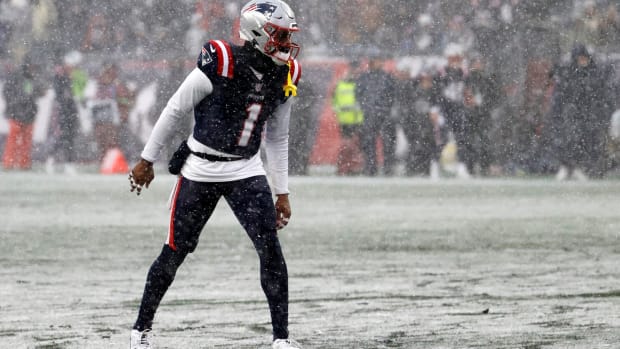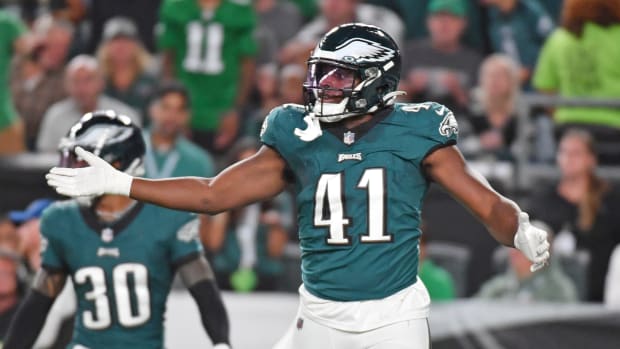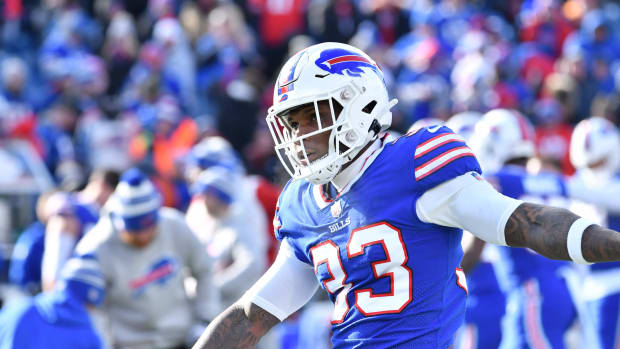
Projecting the NFL Draft: AFC South
Robert Beck/SI (Hundley); Bill Frakes/SI (Gurley); Jason Parkhurst/SI (Fowler)
TEXANS’ PROBLEMS
By Andy Benoit
Head coach Bill O’Brien has acknowledged that his team is in the market for a quarterback. This suggests O’Brien is not titillated with Ryan Mallett, whom he coached in New England.
Houston’s offense is really just one quarterback away. Up front, the line is under 30 at every position except center, where Chris Myers could be cut to save $6 million in cap space. And there’s depth, with interior blockers Ben Jones and Xavier Su’a-Filo, the 33rd overall pick of last year’s draft, waiting in the wings. Aside from right tackle (the so-so Derek Newton is a free agent) there’s nothing to address. Same goes for wide receiver, unless GM Rick Smith stumbles across an eventual replacement for Andre Johnson (and running mate for 2013 first-rounder DeAndre Hopkins).
Defensively, it’s a different story. Five of last year’s starters are free agents: nose tackle Ryan Pickett, outside ’backer Brooks Reed, inside ’backer Akeem Dent, cornerback Kareem Jackson and free safety Kendrick Lewis, who was surprisingly adept in coverage (especially Quarters) as a newcomer last year and is worth re-signing. The nice part is, with several holes to fill but none of them dire, Smith can truly take the best players available.
TEXANS’ SOLUTIONS
By Andy Staples
Bill O’Brien probably can get his quarterback at No. 51 in either UCLA’s Brett Hundley or Baylor’s Bryce Petty. Colorado State’s Garrett Grayson might intrigue O’Brien, but Grayson had to sit out combine workouts with a hamstring injury. His Pro Day could help determine his draft position.
The Texans can use No. 16 to take the best player on the board. Louisville receiver DeVante Parker is better than he showed in the six games he played last season after returning from a broken foot, and he was pretty good in those six games. Even though he still wasn’t quite 100 percent, Parker averaged 142.5 receiving yards a game and 19.9 yards a catch. His combine numbers (4.45-second 40, 36.5-inch vertical jump) suggest he is healthy now. If not Parker, the Texans might want 320-pound Malcom Brown (from nearby Brenham, Texas) to man the middle of the defensive line.
Further down the line, the Texans should be able to find a quality center. Oregon’s Hroniss Grasu was a steadying force on the Ducks’ line and could be available when the Texans select at No. 82. If they want to fill other needs, they probably could pick up Florida’s Max Garcia in a later round.
Texans | Colts | Jaguars | Titans
[soundcloud url="https://api.soundcloud.com/tracks/194017931" params="color=ff5500&auto_play=false&hide_related=false&show_comments=true&show_user=true&show_reposts=false" width="100%" height="166" iframe="true" /]
COLTS’ PROBLEMS
By Andy Benoit
GM Ryan Grigson’s sterling track record is blemished by the trade of a 2014 first-round pick for Trent Richardson. Richardson has been even more sluggish in Indy than he was as a first-round disappointment in Cleveland. Now the Colts again find themselves in need of a feature back, especially with Ahmad Bradshaw unsigned and coming off yet another significant injury (broken leg). The other hole on offense is at center (or right guard, depending which of the two positions 2013 third-rounder Hugh Thornton ends up playing).
The only thing that will keep Grigson from finalizing his talented young offensive roster is pursuing an edge-rusher in the early rounds. Bjoern Werner has not blossomed in this capacity. Apparently the Colts aren’t all that enamored with his sturdy edge-setting ability against the run; if they were, Werner wouldn’t have been a healthy scratch in the AFC Championship versus the power-running Patriots.
The return of Robert Mathis should help the pass rush, but leaning on a 34-year-old who’s coming off an Achilles injury is no way to build a defense. The good news is that last year’s fifth-round pick, Jonathan Newsome, has shown real flashes. In fact, it appears the Colts only need to find one new dynamic edge-rusher.
With the overpaid LaRon Landry cut, safety is a near-vacant position, as Mike Adams and Sergio Brown are free agents. It’s a critical position in Chuck Pagano’s scheme. Lastly, cornerback depth must be considered in the late rounds.
COLTS’ SOLUTIONS
By Andy Staples
In previous drafts, the Colts pick at No. 29 would be a no-brainer given their needs. They would take a pass-rushing 3-4 outside linebacker and try to find a running back in the second or third round. This year, they face a much tougher choice. The no-brainer edge rushers will be gone by this pick, and this is unusually deep and talented running back class.
Draft Projections
NFL film breakdown maven Andy Benoit and college football expert Andy Staples combine their knowledge to peg which prospects fit best with which teams. AFC East: A QB to Gang Green? A new Wilfork in New England?AFC North: A new target for Flacco? A pass-rusher joins the Steel Curtain?
If Georgia back Todd Gurley remains on the board, it complicates the matter even more. Gurley is a dynamic, violent runner who has a higher ceiling than any other back in the draft, but he tore his ACL in November. In all likelihood, the team that takes him will give him a redshirt in 2015 and unleash Gurley on the NFL in 2016. For a Colts team that can win now, that might not be tolerable. So Indianapolis could take Wisconsin’s Melvin Gordon, a one-cut back with great burst and excellent vision. Or the Colts could grab a pass rusher such as Virginia’s Eli Harold and try to find that back later.
This might be the better move, because some great backs could be available at the end of the second round. The Colts could get production out of Nebraska’s Ameer Abdullah, Boise State’s Jay Ajayi, Miami’s Duke Johnson or Indiana’s Tevin Coleman. Coleman might be the most intriguing player of the bunch, and the Colts should be quite familiar with him because they’re only 50 miles from IU’s Bloomington campus. Coleman didn’t have anywhere near the offensive line that the other backs listed above enjoyed, and he still ran for 2,036 yards and averaged 7.5 yards a carry. He probably would have had a higher profile if he hadn’t been overshadowed in his own league by Gordon and later by Ohio State’s Ezekiel Elliott. Coleman didn’t run at the combine because he is recovering from toe surgery.
In round three and beyond, the Colts could address their safety needs. Louisville’s Gerod Holliman, who led the nation with 14 interceptions, could be available in the third. Michigan State’s Kurtis Drummond, who was the eyes and ears of the coaching staff on the field, could be available even later. At strong safety, some team could be very glad it picked up TCU’s Sam Carter either late in the draft or as a free agent. It isn’t easy to be Horned Frogs coach Gary Patterson’s favorite defender, but Carter was that guy for a while.
Texans | Colts | Jaguars | Titans
JAGUARS’ PROBLEMS
By Andy Benoit
Despite unimpressive numbers, there was a lot to like about Blake Bortles’s rookie season, particularly when he was on the move. Now the Jags need to protect him. That’s done through pass-blocking and running the ball, neither of which this team does well. Left tackle Luke Joeckel is quietly trending toward a “bust” label due to a lack of physical strength that leaves him susceptible to the bull rush. But only 21 games into his career, there’s plenty of time for the 2013 No. 2 overall pick to still develop. It’s harder to say the same about right tackle Austin Pasztor.
A foundational ground game would go a long way toward helping whomever is at offensive tackle. Running back Toby Gerhart is suited for situational backup duties. Denard Robinson was an unlikely success, rushing for 488 yards on 107 carries in Weeks 7 to 14 before being shelved by a foot injury. That’s intriguing, but not enough to make GM Dave Caldwell ignore the position. Then again, Caldwell is the one who gave Gerhardt $10.5 million over three years in free agency last year, so perhaps he feels differently about his team’s running back situation.
Caldwell likely feels unsettled about his tight end situation. Marcedes Lewis is injury prone and in the last year of his contract. With a good training camp, a rookie could probably supplant the nine-year veteran.
On defense, Gus Bradley’s Seahawks-style scheme requires physical corners and explosive edge-rushers, both of which the Jags are lacking. (33-yeard-old defensive end Chris Clemons is still effective, but that will have minimal impact on the team’s draft approach.) Depth at linebacker could also be improved.
JAGUARS’ SOLUTIONS
By Andy Staples
Stories Behind the Prospects
Lynden Trail: The draft's biggest mystery man comes from little Norfolk State.T.J. Clemmings: A switch from defense to offensive tackle awakened a monster.Shaq Thompson: Before he was an NFL prospect, he was baseball's worst player.
Unlike the Colts, the Jaguars should have their pick of edge rushers. At No. 3, their challenge will be deciding which player fits their scheme best. Florida’s Dante Fowler Jr. could very well be that player. Fowler played the Buck position in Will Muschamp’s defense; he also played under Dan Quinn as a freshman. Quinn left Florida to replace Jaguars coach Gus Bradley as the Seahawks’ defensive coordinator. The Buck at Florida is similar to the Leo position the Jaguars use (a weakside defensive end who moves around the formation, depending on whether the team wants to show an even- or odd-front look and attempts to wreak havoc in the backfield). Clemson’s Vic Beasley looks athletic enough to do all these things, but he played 25 pounds lighter than Fowler in college. Fowler has the size the Jags want, and he has already shown he can do the job in a similar scheme.
Since Jacksonville picks so early, Wisconsin’s Gordon might still be on the board when they pick in Round 2. So might Florida State offensive lineman Cam Erving. Notice I refer to Erving as an offensive lineman rather than specifying a position. That’s because Erving dominated at center in the second half of last season, but he was the ACC’s best left tackle in 2013. When offensive line coach Rick Trickett realized he had a future first-round left tackle in freshman Rod Johnson, Trickett moved Erving to center to replace the departed Bryan Stork (now a starter in New England). Erving might be the best value pick in the draft because he can succeed at any of the five offensive line spots. If the Jaguars want a right tackle, Erving can do that. If injuries force a line shuffle, Erving makes everything easier.
An intriguing possibility in the later rounds could be Georgia Tech’s Darren Waller. The 6-6, 238-pound Waller worked out with the receivers at the combine—running a receiver-like 4.46-second 40—but he could be a flex tight end in the NFL. He played in an option offense and didn’t produce big numbers until the tail end of his final collegiate season, so the risk/reward is high.
Texans | Colts | Jaguars | Titans
TITANS’ PROBLEMS
By Andy Benoit
Here’s a fascinating dilemma: Do GM Ruston Webster and head coach Ken Whisenhunt take a quarterback with the No. 2 overall pick? Or do they take a closer look at 2014 sixth-rounder Zach Mettenberger, who last season showed the raw pocket passing tools to be an eventual NFL starter? Mettenberger has a ways to go, but his game will progress tenfold if he becomes less methodical—which he likely will with good coaching and greater familiarity with Whisenhunt’s system. If the Titans don’t go with Mettenberger, they must ask themselves What, exactly, were we hoping to see from the youngster last season?
As for the rest of the offense, some have speculated that a running back could be headed Tennessee’s way. But Bishop Sankey has the physical tools to prosper; he just needs refining. Stabilizing the offensive line, where too many players are underachieving and a hole exists at right tackle, is more important than finding a back. And so is revamping the receiving corps, which could lose Nate Washington (free agency) and has yet to get steady play from talented 2013 second-rounder Justin Hunter (28 catches on 68 targets last year).
And there are enough needs on defense to justify putting the QB situation on hold. The Titans didn’t have the man-to-man corners for coordinator Ray Horton’s pressure-centric scheme. Jason McCourty is really a No. 2 and Blidi Wreh-Wilson is really a specials teams guy. If they run more of Dick LeBeau’s scheme, they’d need more zone-oriented defenders, which you can find in the middle rounds. There are also ill-fitting players up front, most notably Derrick Morgan, a 4-3 defensive end who was miscast as a 3-4 outside linebacker. He’s not worth re-signing. Neither is inside ’backer Colin McCarthy, though with plenty of options at this position (Wesley Woodyard, Zach Brown and Avery Williamson, who will emerge as the leader here), the focus can be on finding another defensive lineman or two.
TITANS’ SOLUTIONS
By Andy Staples
If the Titans decide to choose a quarterback, then the No. 2 pick is easy. They’ll whichever of the big two—Jameis Winston and Marcus Mariota—the Buccaneers don’t take. Should the Titans decide not to take a quarterback, they face a more complex decision.
Bedard's Draft Breakdowns
Marcus Mariota: Everything but the fireJameis Winston: Is he worth the trouble?Melvin Gordon: Can he break the RB first-round drought?
If they want a 3-4 outside linebacker, they can take Florida’s Fowler or Clemson’s Beasley. But that would require them to pass on USC’s Leonard Williams, a 6-5, 300-pounder physically suited to play every possible position on the interior line. Williams’ versatility is what makes him so valuable. He can play end in a 3-4. He can play three technique in a 4-3. He can play one technique in a 4-3. He can play over the center on third and long. He probably could slide all the way outside and rush the passer if needed. Williams’ versatility makes him incredibly valuable; it would be surprising if he wasn’t the first non-quarterback taken.
The Titans may have a chance to address their cornerback need later with one of the draft’s most intriguing players. Quinten Rollins spent his first four years at Miami (Ohio) locking down opposing point guards. The 6-1, 203-pounder decided to play football in his final year of eligibility and wound up winning the MAC Defensive Player of the Year award. His 4.58-second 40 at the Combine could scare off teams that might have considered the raw Rollins an earlier pick. That means he might be hanging around when the Titans pick in the third round. If they want to take a more established big corner at the top of the second, LSU’s Jalen Collins (6-2, 198 pounds) might still be available, but his 4.43-second 40 at the combine might have solidified his spot in Round 1.
Texans | Colts | Jaguars | Titans
Follow The MMQB on Facebook, Twitter and Instagram.
[widget widget_name="SI Newsletter Widget”]











































